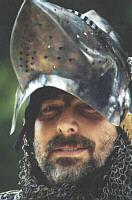Journal of Western Martial Art
Volume 2000
Archived Articles
| 12/00 | Dr. Eli Steenput - Vollstandiges Ring-Buch by Johann Georg Passchen
This is an interesting little 17th century wrestling manual, with focus on unarmed defence, and surprisingly complete in the types of techniques covered. It is also boringly repetitious and the explanations are not extraordinarily clear. |
| 11/00 | Björn Hellqvist - Oakeshott's Typology
This is an attempt to introduce the reader to Oakeshott's sword blade typology. Ewart Oakeshott is perhaps the most noted student of swords, and his contribution to our knowledge is significant. In order to make his research easier, he divided the swords into types. In contrast to other typologies, like Petersen's Viking sword typology that only focuses on the hilt form, Oakeshott's typology concentrates on the blade and its function. |
| 10/00 | Brian Price - Chivalry and the Modern Practice of the Medieval Martial Arts
The recent interest in Medieval and Renaissance martial arts is a wonderful thing. Drawn to the tantalizing world of historical techniques as expressed through the fechtbuchen (fighting books), reenactors, martial artists, tournament society members and historical fencers have begun to communicate, creating a rich new renaissance of learning with respect to the practice of medieval fighting. |
| 10/00 | Dr. Eli Steenput - Clear Instructions to the Excellent Art of Wrestling
Clear instructions to the excellent art of wrestling, teaching how one can defend oneself in all occurrences of violence, and how to counter all grips, pushes, punches. Most useful against troublemakers and those seeking to offend others, or that threaten one with a knife. |
| 05/00 | Stephen Hand - A Matter of Time
You face your opponent en guarde, waiting for his move. He lunges at the left side of your chest. Without thinking you parry the thrust across your body and then extend your sword in a counterthrust, aiming at the center of your opponent's chest. |
| 05/00 | Tony Wolf - JUEGO DEL PALO - Stick Fencing of the Canary Islands
Juego del Palo ("stick play") is practiced as a folk art, sport and self-defense system on the Canary Islands, a mountainous island chain off the coast of Morocco. It features a wide variety of Estilos (styles), which are usually named after the families which have preserved and perpetuated specific teaching systems, and also many distinct juegos (games) featuring different rules, strategies and techniques. |
| 04/00 | Colin Roberts - About Cornish Wrestling
Cornish Wrestling, or 'wrasslin' as we call it, is an ancient form of one-on-one combat, similar in style to many other forms of Celtic wrestling. It certainly has no similarity with the wrestling seen on TV where entertainment rather than competitiveness is the aim. |
| 03/00 | Neil H. T. Melville - The Incised Effigial Stone at Foveran, Aberdeenshire
On the 24th of July 1411 Donald, Lord of the Isles, at the head of a Highland army numbering, so it was said, 10,000 men, arrived at the village of Harlaw near inverurie, less than 20 miles from Aberdeen. Donald claimed the Earldom of Ross by right of his wife and was determined to assert his title by force of arms against the counterclaim of the regent, the Duke of Albany, on behalf of his son, John, Earl of Buchan. |
| 03/00 | Ken Pfrenger - Early Cornish Wrestling
Very few western martial traditions have a verifiable unbroken line of practice from Medieval times. The same can be said for Asian martial traditions as well. The indigenous wrestling of Englands West Country and of the Cornish people themselves has a history that extends before Medieval times and possibly back into ancient times as well. |
| 01/00 | Peter Kautz - The Gripping History of Glima
Glima translates literally as "The Game of Joy", and is an art roughly 1100 years old. It was brought to Iceland by Viking settlers, and has been practiced as a folk art ever since. It is mentioned in writing in the "Jonsbok" law-book in 1325, "Whosoever participates in a contest of friendly wrestling or hide-tugging does so on his own responsibility". |
| 01/00 | Neil H. T. Melville - The Origins of the Two-Handed Sword
Any sword which is to be regarded as a two-hander must, by reason of its dimensions and weight, require two hands for its effective management. Hence the blade, as well as the hilt, must be longer than norm, i.e. over 100cm. Secondly, the hilt of the true two-hander should not merely accommodate two hands but be long enough for the two hands holding it to be kept apart, in order to give a fulcrum effect; and the greater the possible distance between the hands the more easily could the long, heavy blade be manoeuvred for an offensive cut or a defensive counterblow. |
| 12/99 | Greg Mele - The Problem of Armour in Medieval Combat Reconstruction
Today a wide variety of groups practice historical swordplay, to various degrees of realism. These include "live-fantasy" boffer fighters, for whom "Medieval combat" is simply a facet of the bigger game, the martial sport of many American derived medieval "recreation" societies, the "battle pageants" many living history groups perform for the public, and the pure martial focus of organizations such as the Academy of European Medieval Martial Arts or the Historical Armed Combat Association. |
Feedback
You are welcome to contact the editor, David Cvet with or to submit via email, "". Letters to the editor will be published in the above listing in a similar fashion as articles submitted.
Please include your name, city, prov/state with your letter and indicate whether or not your email addy can be included in your letter online.
Resources
- You can find more information on medieval fighting arts at the Academy of European Medieval Martial Arts website or to view an extensive online library of medieval fighting arts treatises visit the AEMMA Online Library.
The Editors
, Executive Editor - JWMA and JManly
David is the Founder and President of the Academy of European Medieval Martial Arts (AEMMA), an organization dedicated to the resurrection and formalization of medieval martial arts training systems. He received training in Milan, Italy employing steel weapons in longsword techniques and has participated in various organizations dedicated to studying the Middle Ages. His background and experience having fired his desire to pursue a formal medieval martial arts training program, he founded AEMMA in mid-1998. He is a member of the advisory board of the Swordplay Symposium International (SSI), an interdisciplinary colloquium of historical fencing specialists dedicated to promoting and advancing the study of Western swordsmanship, and participating board member of the Association for Historical Fencing (AHF). David received his appointment of free scholler in Oct, 2000 and the "Acknowledged Instructor" (AI) designation for armoured combat instruction in Oct, 2000 by the International Masters at Arms Federation (IMAF).
, Editor - JManly
Tony is a professional fight director and martial arts/stage combat tutor. Since 1978 he has traversed a wide range of Asian, Polynesian and European martial arts, with a particular interest in both European "folk styles" and the combatives of the late 1800s. He was a pioneer of padded-attacker self-defence training in his home country of New Zealand and serves as an advisor for several international martial arts and stage combat organisations.
Tony's fight direction and action sequences have been featured in over one hundred and seventy feature film, television, theatre, opera and ballet productions. Between 1998-2000 he served as the Fighting Styles Designer for Peter Jackson's Lord of the Rings movie trilogy and in 2002 he toured Japan with the Washington Opera Company's production of Otello starring Placido Domingo. Tony has taught, directed and performed throughout New Zealand, as well as in Australia, the USA, England, Ireland, Canada and Japan. He lives in Wellington, New Zealand with his son, Josh.
EJMAS Copyright © 2003 All Rights Reserved ISSN 1492-1642

